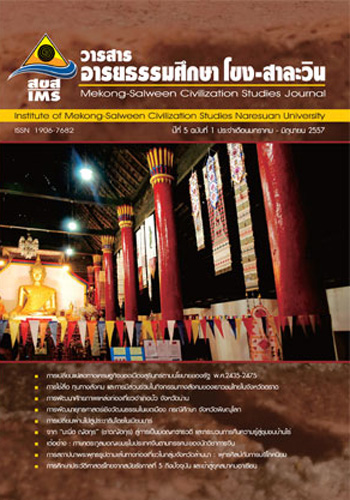การพัฒนาศักยภาพแหล่งท่องเที่ยวอำเภอปัว จังหวัดน่าน
Main Article Content
Abstract
บทความวิจัยนี้เป็นส่วนหนึ่งของโครงการวิจัยแผนพัฒนาการท่องเที่ยวอย่างยั่งยืน อำเภอปัว จังหวัดน่าน มีวัตถุประสงค์เพื่อศึกษาพฤติกรรม ความพอใจของนักท่องเที่ยวและศักยภาพแหล่งท่องเที่ยว อำเภอปัว จังหวัดน่าน วิธีการศึกษาได้แก่ 1) การสอบถามจากนักท่องเที่ยวชาวไทย จำนวน 308 คน 2) การสำรวจศักยภาพแหล่งท่องเที่ยว 3) การจัดสนทนากลุ่มกับผู้ประกอบการและผู้นำชุมชน และ 4) การสัมภาษณ์เจ้าหน้าที่องค์กรปกครองส่วนท้องถิ่นและหน่วยงานภาครัฐ จำนวน 10 คน ผลการศึกษาพฤติกรรมและความพอใจพบว่านักท่องเที่ยวมีความประทับใจต่อกิจกรรมการท่องเที่ยวทางธรรมชาติและประวัติศาสตร์ ซึ่งสามารถพัฒนาให้เป็นจุดขายของอำเภอปัว และจากการประเมินศักยภาพแหล่งท่องเที่ยวสามารถแบ่งกลุ่มเร่งด่วนในการพัฒนาเป็น 3 กลุ่ม ดังนี้ กลุ่มที่ 1 แหล่งท่องเที่ยวที่มีความสำคัญสูง ได้แก่ อุทยานแห่งชาติดอยภูคา วัดปรางค์ วัดต้นแหลง วิถีชนเผ่าตำบลป่ากลาง และโฮมสเตย์ตำบลศิลาเพชร กลุ่มที่ 2 แหล่งท่องเที่ยวที่มีความสำคัญปานกลาง ได้แก่ น้ำตกศิลาเพชร เครื่องเงินตำบลป่ากลาง เทศกาลกว่าง วัดพระธาตุเบ็งสกัด เทศกาลดอกชมพูภูคา และกลุ่มที่ 3 แหล่งท่องเที่ยวที่มีความสำคัญต่ำ ได้แก่ วัดร้องแงง วัดพระธาตุจอมแจ้ง วัดพระธาตุจอมทอง อนุสาวรีย์พญาผานอง ทั้งนี้การประเมินศักยภาพแหล่งท่องเที่ยวเพื่อจัดอันดับความเร่งด่วนในการพัฒนาเป็นเครื่องมือที่มีความจำเป็นสำหรับภาครัฐโดยเฉพาะองค์กรปกครองส่วนท้องถิ่น ในการกำหนดยุทธศาสตร์ แผนงาน/โครงการร่วมกันเพื่อให้เกิดการพัฒนาการท่องเที่ยวอย่างมีประสิทธิภาพมากขึ้นและเป็นการกระจายผลประโยชน์สู่ชุมชน ตลอดจนการเข้ามามีส่วนร่วมของชุมชนในการกำหนดเกณฑ์และความพร้อมในการพัฒนาแต่ละด้านเพื่อนำไปสู่การพัฒนาอย่างยั่งยืน
The Tourist Destination’s Capacity Development for Pua District, Nan Province
This paper was part of the research project on sustainable tourism development plan for Pua district, Nan province. It aimed to study the tourist behavior, tourist satisfaction, and tourist destination’s capacity. The study method involved 4 processes: (1) applying the questionnaires to ask 308 both local administration and government sector. For tourist behavior and satisfaction, the result revealed that the tourists’ impression toward Pua district was on its nature and history related activities, implying that these two functions could later be developed into the tourism highlights. And from evaluating the tourist destinations’ capacity, we could classify them into 3 groups as follows. Group 1, the highly significant, included Doi Phu Kha National Park, Wat Prang, Wat Ton Laeng, Ethnic Lifestyle in Pa Klang District, and Homestay in Sila Petch District. Group 2, the moderately significant, included Sila Petch Waterfall, Silverware of Pa Klang District, Hercules Beetle Fighting Festival, Wat Phrathat Beng Sakat, Chompoo Phu Kha Flower Festival. Group 3, the least significant, composed of Wat Rong Ngang, Wat Prathat Chom Chaeng, Wat Prathat Chom Thong, Phaya Pha Nong Monument. Fundamentally, the government sector needs an evaluation of tourist destination’s capacity as a crucial tool for prioritizing the need for development. Particularly for the local administration, it then could clearly define its strategy, action plans or collaboration projects to effectively develop the tourism. Also, the local administration will be benefited more from tourism industry. Being more aware of this fact, the people in the community will come to participate in establishing the regulation toward tourism, and prepare themselves to be ready for sustainable development.


